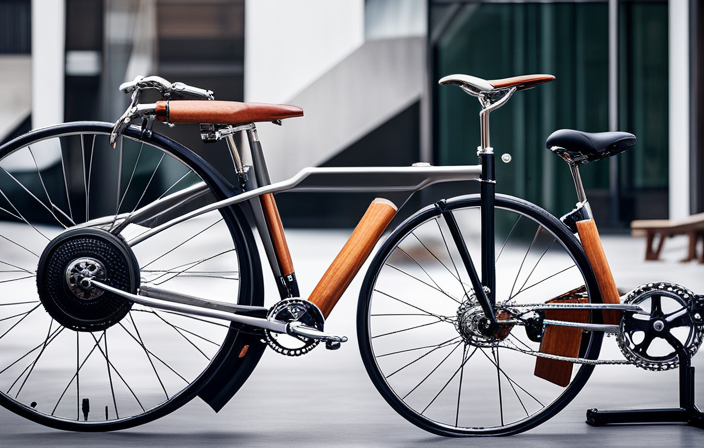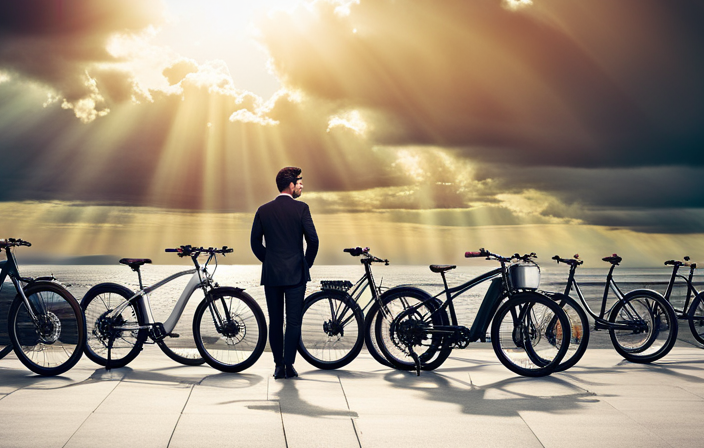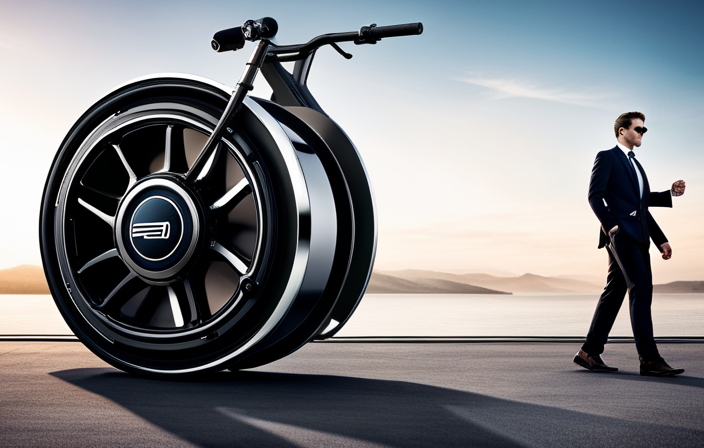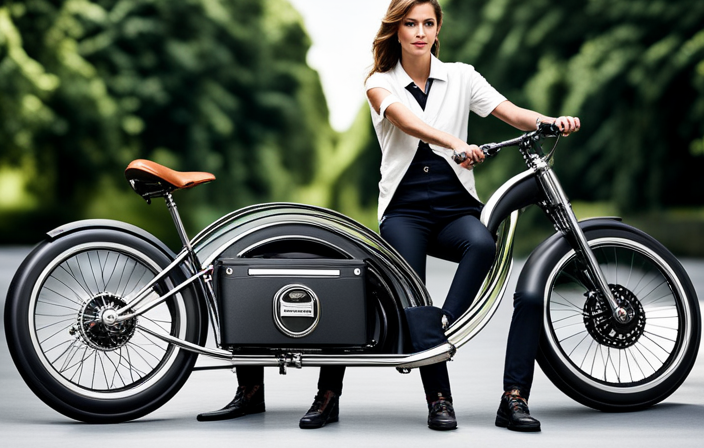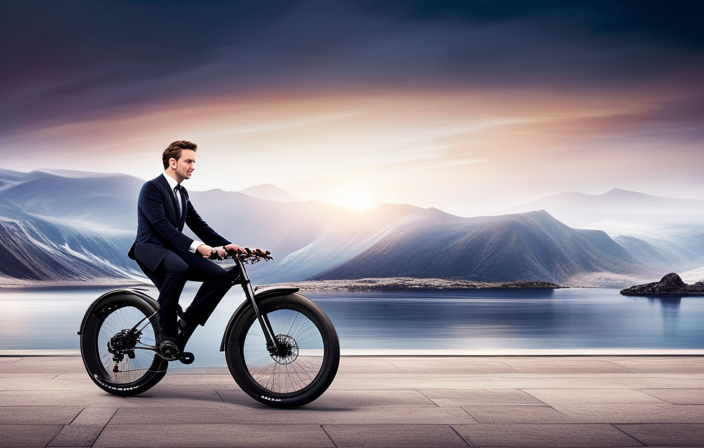Are you tired of riding around on a slow and ordinary bike? Do you crave the exhilarating speed and power of a high-performance machine? Look no further!
In this article, I will guide you through the step-by-step process of transforming your bike into a 40 mph electric beast. With the right materials, tools, and know-how, you’ll be zooming down the streets in no time.
Get ready to experience the thrill of a lifetime with your very own high-speed electric bike!
Key Takeaways
- Evaluate bike suitability and choose the right kit by assessing factors such as bike weight, frame strength, drivetrain, brakes, and wheels condition.
- Consider factors like desired battery range, power, weight, voltage, and capacity to choose a battery that suits your needs.
- Gather necessary materials and tools including an electric bike conversion kit, basic hand tools, and additional materials like zip ties and electrical tape.
- Follow the step-by-step process of removing the bike’s original components, installing the electric motor and battery, connecting the wiring and controls, testing the bike’s performance, and ensuring safety and legal compliance.
Assess Your Bike’s Suitability for Conversion
Assess if your bike’s suitable for conversion by first evaluating its performance. Consider the weight of the bike, as a heavier bike may be more difficult to convert to electric. Look at the frame and ensure it is sturdy enough to support the additional weight of the electric components. Evaluate the condition of the drivetrain, brakes, and wheels, as these will affect the overall performance and safety of the converted bike.
Next, assess the battery options for your electric bike. Determine the range and power you desire, as this will dictate the type and size of battery you will need. Consider factors such as weight, voltage, and capacity when choosing a battery that best suits your needs.
Now that you have assessed your bike’s suitability for conversion and evaluated battery options, it’s time to gather the necessary materials and tools for the project.
Gather the Necessary Materials and Tools
First, you’ll need to gather all the required materials and tools for this project. Gathering materials is an essential step in the process of converting your bike into an electric one.
To start, you’ll need a suitable electric bike conversion kit that includes a motor, battery, and controller. Make sure to choose a kit that is compatible with your bike’s frame and wheel size.
Additionally, you’ll need basic hand tools such as wrenches, screwdrivers, and pliers for installation purposes. It’s important to source high-quality tools to ensure a smooth and efficient conversion process.
You may also need additional materials like zip ties, electrical tape, and wire connectors for securing and organizing the wiring.
With all the necessary materials and tools gathered, you can now move on to the next step of choosing the right electric bike conversion kit, where we’ll explore various options to suit your needs.
Choose the Right Electric Bike Conversion Kit
Once you’ve gathered all the necessary materials and tools, you can now choose the perfect conversion kit for your needs. When it comes to electric bike conversion kits, there are several pros and cons to consider.
On the plus side, conversion kits are generally more affordable than buying a brand new electric bike. They also allow you to customize your existing bike, which can be a big advantage if you have a bike you already love. However, conversion kits can be more challenging to install and may require some technical know-how.
When choosing a battery for your electric bike conversion, there are a few tips to keep in mind. Consider the battery’s capacity, weight, and range, as these factors can greatly impact your bike’s performance. Additionally, ensure that the battery is compatible with your conversion kit.
With the right conversion kit and battery, you can transform your regular bike into a powerful electric one. Now, let’s move on to the next step and remove the bike’s original components.
Remove the Bike’s Original Components
To remove the original components of the bike, start by disconnecting the chain and removing the pedals. This will allow you to access the drivetrain and other crucial parts.
Next, remove the existing derailleur system by loosening the bolts and disconnecting the cables. Carefully remove the front and rear brake assemblies, making sure to disconnect any cables or wires attached to them.
Once these components are removed, you can begin replacing them with the upgraded parts included in the electric bike conversion kit. This may involve installing a new drivetrain system, brake assemblies, and other necessary components.
After upgrading the bike’s components, you can proceed to install the electric motor and battery, which will be covered in the subsequent section.
Install the Electric Motor and Battery
Now you can proceed with installing the electric motor and battery. Here are the steps to follow:
-
Electric motor installation:
-
Begin by positioning the motor in the desired location on the bike frame, ensuring it is securely attached.
-
Connect the motor to the bike’s drivetrain system, ensuring proper alignment and tension.
-
Securely fasten the motor in place using the provided mounting hardware.
-
Double-check all connections to ensure they are secure and aligned correctly.
-
Battery installation:
-
Choose a suitable location on the bike frame to mount the battery pack.
-
Attach the battery securely using the provided mounting brackets or straps.
-
Connect the battery to the electric motor using the appropriate wiring harness.
-
Confirm that the battery is securely fastened and all connections are tight.
With the electric motor and battery successfully installed, it’s time to connect the wiring and controls for seamless operation.
Connect the Wiring and Controls
After successfully installing the electric motor and battery, it’s time to connect the wiring and controls for seamless operation.
To ensure a smooth and efficient connection, refer to the wiring diagrams provided by the manufacturer. These diagrams will guide you through the process of connecting the various wires and components. Pay close attention to the color-coding of the wires, as this will help you identify the correct connections.
In case you encounter any issues, here are a few troubleshooting tips to consider: check for loose connections, verify that the wires are properly insulated, and ensure that all connections are securely tightened.
Once the wiring and controls are properly connected, you can move on to the next step of testing and fine-tuning the electric bike to maximize its performance and achieve the desired speed.
Test and Fine-Tune the Electric Bike
First, you’ll need to test and adjust the electric bike to optimize its performance and achieve your desired speed.
Begin by taking the bike for a test ride to evaluate its overall performance. Pay attention to the acceleration, top speed, and handling characteristics. Use this test ride to identify any areas that may need improvement or fine-tuning.
Once you have gathered the necessary data, conduct a performance analysis to assess the bike’s power output, battery efficiency, and overall performance. This analysis will help you determine if any adjustments or modifications are necessary to reach your goal of a 40 mph electric bike.
By thoroughly testing and fine-tuning the bike, you can ensure that it is operating at its maximum potential.
Next, we’ll discuss how to ensure the bike meets safety and legal requirements for road use.
Ensure Safety and Legal Compliance
To ensure the safety and legal compliance of your electric bike, it is important to prioritize adherence to road regulations and safety standards. Safety precautions are essential when riding a high-speed electric bike.
Always wear a properly fitting helmet to protect your head in case of accidents. Additionally, consider wearing other safety gear such as knee and elbow pads. It is also crucial to have proper lighting on your bike, including front and rear lights, reflectors, and a horn or bell to alert other road users.
When it comes to legal requirements, check your local laws and regulations regarding electric bikes. Some jurisdictions may require registration, insurance, or specific equipment. Make sure your bike meets all the necessary legal requirements before riding.
By following these safety precautions and legal requirements, you can enjoy your high-speed electric bike with peace of mind.
Enjoy Your High-Speed Electric Bike
When riding your high-speed electric bike, you can fully embrace the thrill and freedom it offers. To enhance your riding experience, there are various customization options available. You can upgrade the seat for increased comfort, install a larger battery for extended range, or add a suspension system for a smoother ride. However, it’s important to ensure that any modifications comply with safety regulations and do not compromise the bike’s structural integrity.
To enjoy your high-speed electric bike safely, it is crucial to follow some safety precautions. Always wear a helmet and other protective gear, obey traffic laws, and maintain a safe distance from other vehicles. Additionally, regularly check the brakes, tires, and lights to ensure they are in good working condition.
When it comes to maintenance and troubleshooting tips, it’s essential to have a basic understanding of the bike’s components and their functions. This knowledge will help you identify and resolve any issues that may arise.
Maintenance and Troubleshooting Tips
Now that you’re enjoying the thrill of riding your high-speed electric bike, it’s important to keep up with regular maintenance and troubleshoot any issues that may arise. Proper maintenance ensures your bike continues to perform at its best and extends its lifespan.
To help you with this, here are some essential troubleshooting techniques and a maintenance schedule to follow:
-
Troubleshooting Techniques:
- Check the battery connection and ensure it is securely attached.
- Inspect the motor for any signs of damage or overheating.
- Test the brakes and ensure they are functioning properly.
-
Maintenance Schedule:
- Clean your bike regularly to prevent dirt and debris buildup.
- Lubricate the chain and gears to reduce friction and improve performance.
- Inspect the tires for wear and tear and maintain proper tire pressure.
By following these troubleshooting techniques and sticking to a maintenance schedule, you can keep your high-speed electric bike in top shape and enjoy its speed and efficiency for years to come.
Frequently Asked Questions
What are some common safety precautions to take when riding a high-speed electric bike?
When riding a high-speed electric bike, it is crucial to wear protective gear for safety. Maintaining balance and stability at high speeds is essential. Follow these tips to ensure a safe and enjoyable ride.
Can I convert any type of bike into an electric bike?
Converting any bike into an electric bike involves a step-by-step process. The benefits of this conversion include increased speed, reduced effort, and a more eco-friendly mode of transportation.
How long does it typically take to complete the conversion process?
The conversion process typically takes several hours to complete, depending on the complexity and your experience level. It’s important to note that speed limitations may vary based on factors such as motor power and local regulations.
Are there any legal regulations or restrictions for riding a high-speed electric bike?
There are legal regulations and restrictions for riding high-speed electric bikes. These regulations include speed limits, which vary depending on the location. It is important to check the specific regulations in your area before riding.
What are some common maintenance and troubleshooting issues that may arise with an electric bike conversion?
Battery issues and motor malfunctions are common maintenance and troubleshooting problems with electric bike conversions. Proper maintenance, such as checking battery connections and inspecting motor components, can help prevent these issues.
Conclusion
In conclusion, transforming a regular bike into a high-speed electric bike is an exciting project that requires careful planning and execution. By following the steps outlined in this article, you can create a 40 mph electric bike that will provide you with an exhilarating and efficient mode of transportation.
For example, John, a bike enthusiast, successfully converted his old mountain bike into a speedy electric bike using a conversion kit. Now, he effortlessly cruises through city streets, reaching his destination in record time while enjoying the thrill of the ride.

